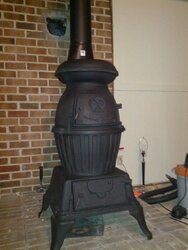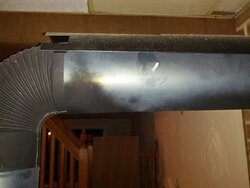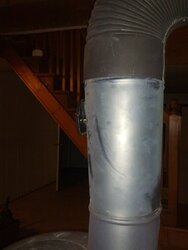I probably should have joined the forum a while ago but I finally have a question I can't find the answer to and need some help. Okay so here it is...
I just moved to a house that has electric baseboard heat. There's no way I can afford to heat with them and I have a decent amount a free wood available to me so I decided to install a wood stove. I plan on buying a new wood stove next year but I needed to save money now so I installed the only free stove I could get my hands on. An old Cannon Heater #18. Eats through wood like crazy but it'll heat the whole house.
Anyway it's only been installed for about a month now and a while ago I started to notice it was turning a grayish silver in parts of the stove pipe. I usually burn at the high end of the optimal range (according to the stove pipe thermometer) but I never go over 700. I assumed it was just crappy stove pipe. Especially after I couldn't find anything online saying any different. Well tonight I loaded up the stove and had the door on the bottom hanging open to get it going good. I walked away for a minute and when I came back I noticed an unpleasant smell and some smoke coming out from under the heat shield. (The thermometer on the stove pipe read about 500 at this point). Then I noticed the stove pipe under the heat shield had a subtle red glow to it. I quickly closed up the stove and it went away. After doing a little research all I could find was people saying this happens when having a chimney fire or that creosote stuck to the inside of the stove pipe is burning.
I'll be taking the stove pipe apart tomorrow but I doubt either of the above are an issue. I mean I've only been using the stove for a month now and there was no other sign of an issue during the incident. I did realize the flue is a little large for stove pipe. Seeing as how the stove pipe is 6 in. and the flue is 13X9. But I figured it would be okay for one year seeing as how the the stove is isn't airtight, I burn a hot fire, and the draft is good. So what could be the issue? Could it be as simple as bad stove pipe or something else? Can I give the fire too much air at the beginning of a load etc...?
***I've attached pictures of the stove and stove pipe in case that helps. Thanks in advance for any suggestions and for reading all of that.
I just moved to a house that has electric baseboard heat. There's no way I can afford to heat with them and I have a decent amount a free wood available to me so I decided to install a wood stove. I plan on buying a new wood stove next year but I needed to save money now so I installed the only free stove I could get my hands on. An old Cannon Heater #18. Eats through wood like crazy but it'll heat the whole house.
Anyway it's only been installed for about a month now and a while ago I started to notice it was turning a grayish silver in parts of the stove pipe. I usually burn at the high end of the optimal range (according to the stove pipe thermometer) but I never go over 700. I assumed it was just crappy stove pipe. Especially after I couldn't find anything online saying any different. Well tonight I loaded up the stove and had the door on the bottom hanging open to get it going good. I walked away for a minute and when I came back I noticed an unpleasant smell and some smoke coming out from under the heat shield. (The thermometer on the stove pipe read about 500 at this point). Then I noticed the stove pipe under the heat shield had a subtle red glow to it. I quickly closed up the stove and it went away. After doing a little research all I could find was people saying this happens when having a chimney fire or that creosote stuck to the inside of the stove pipe is burning.
I'll be taking the stove pipe apart tomorrow but I doubt either of the above are an issue. I mean I've only been using the stove for a month now and there was no other sign of an issue during the incident. I did realize the flue is a little large for stove pipe. Seeing as how the stove pipe is 6 in. and the flue is 13X9. But I figured it would be okay for one year seeing as how the the stove is isn't airtight, I burn a hot fire, and the draft is good. So what could be the issue? Could it be as simple as bad stove pipe or something else? Can I give the fire too much air at the beginning of a load etc...?
***I've attached pictures of the stove and stove pipe in case that helps. Thanks in advance for any suggestions and for reading all of that.





